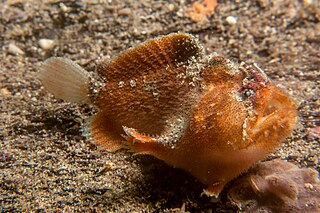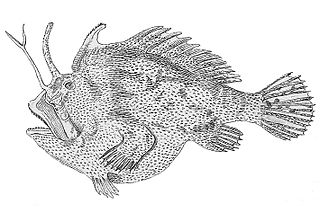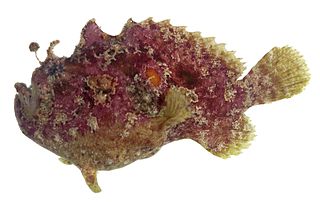
Frogfishes are any member of the anglerfish family Antennariidae, of the order Lophiiformes. Antennariids are known as anglerfish in Australia, where the term "frogfish" refers to members of the unrelated family Batrachoididae. Frogfishes are found in almost all tropical and subtropical oceans and seas around the world, the primary exception being the Mediterranean Sea.

The sargassum fish, anglerfish, or frog fish is a species of marine ray-finned fish belonging to the family Antennariidae, the frogfishes, the only species in the genus Histrio. It lives among Sargassum seaweed which floats in subtropical oceans. The scientific name comes from the Latin histrio meaning a stage player or actor and refers to the fish's feeding behaviour.

The ocellated frogfish is a species of marine ray-finned fish belonging to the family Antennariidae, the frogfishes. This fish is found in the Western Atlantic Ocean.

The psychedelic frogfish is a yellow-brown or peach colored frogfish named for its pink and white stripes arranged in a fingerprint pattern. The fish is from waters near Ambon Island and Bali, Indonesia.

Histiophryne bougainvilli, commonly known as the Smooth Anglerfish, is a frogfish found in the waters of Queensland, New South Wales, and Western Australia. There are an estimated 40 specimens known.
The cryptic anglerfish is a frogfish found in waters ranging from Taiwan to South Australia. There are an estimated 75 specimens known. The luring appendage on its forehead is reduced to nearly nothing.

Histiophryne is a genus of marine ray-finned fishes belonging to the subfamily Histiophryninae in the family Antennariidae, the frogfishes. These fishes are found in waters ranging from Taiwan to South Australia. There are currently five known species. These fishes are easily distinguished from other anglerfishes as having a reduced luring appendage, a highly evolved form of the first dorsal fin spine.

Antennarius is a genus marine ray-finned fishes belonging to the family Antennariidae, the frogfishes. The fishes in this genus are found in warmer parts of the Atlantic, Indian and Pacific Oceans.
David J. Hall is an underwater wildlife photographer, author, and naturalist. His photographs have appeared in hundreds of books, magazines, calendars, and other print media worldwide, including National Geographic, Smithsonian, Natural History, Sierra, Time, Science, Scientific American, Geo, Terre Sauvage, and BBC Wildlife. He is the recipient of many awards, including first place in two categories of the BBC Wildlife Photographer of the Year, first place in both the Nature's Best and Sierra magazine competitions, and third place in the Festival Mondial de l'Image Sous-Marine. He is also the recipient of an award from the International Institute for Species Exploration, for research leading to his co-authorship of the description of Histiophryne psychedelica, Psychedelic Frogfish, and generally considered to be one of the ten most significant new species described in 2009.

Antennatus is a genus of marine ray-finned fishes belonging to the family Antennariidae, the frogfishes. The fishes in this genus are found the Indian and Pacific Oceans.

Echinophryne is a genus of marine ray-finned fishes belonging to the subfamily Histiophryninae in the family Antennariidae, the frogfishes. The fishes in this genus are endemic to the waters off Australia.

Fowlerichthys is a genus of marine ray-finned fishes belonging to the family Antennariidae, the frogfishes. The fishes in this genus are found the Atlantic, Indian and Pacific Oceans.

Kuiterichthys is a genus of marine ray-finned fishes belonging to the subfamily Histiophryninae in the family Antennariidae, the frogfishes. These fishes are endemic to Australia.

Nudiantennarius is a monospecific genus of marine ray-finned fish belonging to the family Antennariidae, the frogfishes. The only species in the genus is Nudiantennarius subteres, the deepwater frogfish. This fish is found in the Western Pacific Ocean.

Abantennarius coccineus, the scarlet or freckled frogfish, is a species of frogfish originally classified as Chironectes coccineus and Antennarius coccineus. It lives within tropical waters and has a central distribution being around Indo-East-Pacific areas- excluding Hawaii. The habitat of the scarlet frogfish is in the shallow zones of the ocean. It is found within reef areas, in rocky mounds or sponges where there are places for it to hide amongst from predators. The scarlet frogfish comes in a variety of colours, from tan and brown colours to bright reds and yellows and will grow to a maximum length of 13 centimetres (5.1 in). It can be identified taxonomically through its pectoral rays, the presence of dark patches that appear on its fins and body, along with its lack of distinctive tail base. The scarlet frogfish is not harmful to humans and is not caught by fisheries for consumption purposes, however it has been caught previously for studies relating to the abundance of reef-dwelling fish and as bycatch of shrimp trawling. Similar to other frogfish species, the scarlet frogfish is a predatory carnivore and exhibits a low degree of sociality, only interacting with other scarlet frogfish during their mating period.

Echinophryne crassispina, the prickly anglerfish, prickly frogfish or thick-spined anglerfish, is a species of marine ray-finned fish belonging to the subfamily Histiophryninae in the family Antennariidae, the frogfishes. These fishes are endemic to the temperate waters of southern Australia.
Histiophryne maggiewalker, known as the Queensland frogfish, is a species of fish in the family Antennariidae. It is known only from Australia, where it occurs in shallow inshore waters at a depth range of 7 to 12 m. Males of the species reach 5.5 cm SL, whereas females are slightly larger at up to 6 cm SL. The species was described in 2011 by Rachel Arnold and Theodore Pietsch from six specimens collected in shallow waters off Queensland, and it is named for Maggie Walker, for her service and dedication to science and education at the University of Washington and the Burke Museum of Natural History and Culture.
Histiophryne pogonia is a species of fish in the family Antennariidae. It is native to the Pacific Ocean, where it is known from Indonesia and the Philippines, specifically the shallow inshore waters of Lombok, Komodo, and possibly Cebu. It is a reef-dwelling species that is thought to be more active at night. Males of the species reach 4.8 cm SL, whereas females are slightly larger at up to 5.4 cm SL. Two specimens of H. pogonia were observed to live peacefully in an aquarium for multiple months, which suggests that this species may be less aggressive and less cannibalistic than members of genera such as Antennarius or Histrio. This species can be distinguished from its congeners by its extremely small illicium, although it does have a distinct esca unlike members of the genus Echinophryne. While it was initially described as H. pogonius, FishBase and WoRMS list it as H. pogonia, with FishBase marking H. pogonius as a misspelling.
Kuiterichthys pietschi is a species of fish in the family Antennariidae. It was described in 2013 by Rachel J. Arnold from 20 specimens collected at depths of 60 to 89 m off New South Wales, Australia. It differs from its congener K. furcipilis in number of fin rays, number of vertebrae, and escal morphology. It is named in honor of Theodore Wells Pietsch.

Histiophryninae, the star-fingered frogfishes, is a subfamily of marine ray-finned fishes belonging to the family Antennariidae, the frogfishes. The species in this family are found in the Indian and Western Pacific Oceans.











